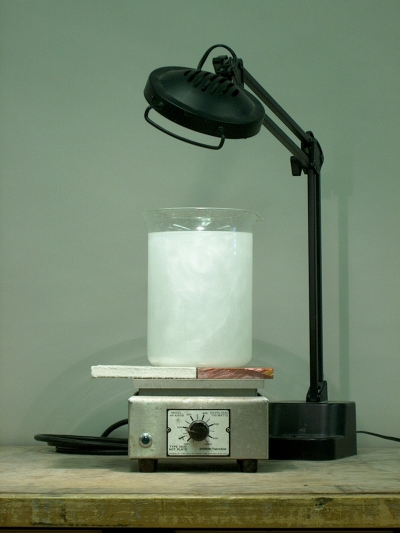

Convection is the transfer of heat via the motion of a heated fluid. This can happen in two ways. In natural convection (or free convection), a portion of the fluid receives heat from a heat source. This raises the average kinetic energy of the molecules in that portion, which decreases its density. The heated, less dense fluid rises, and cooler, denser fluid from above sinks to replace it. (See demonstrations 36.34 -- diet vs. regular Coke, 36.36 -- Archimedes’ principle, 36.37 -- Cartesian divers or 36.39 -- helium-filled balloon). The heated fluid that has risen loses its heat to the surrounding fluid and cools, thus becoming denser. It then sinks to the bottom to be heated again and repeat the process. This type of convection occurs in the earth’s mantle and in the oceans, and in the atmosphere (the troposphere, the lowest region) it is responsible for surface winds and weather. (In the atmosphere, as the air rises it cools as a result of adiabatic expansion.) Convection also occurs in the sun, and plays an important role in ovens and the heating of rooms. In forced convection, one uses a pump or blower to push the heated air from the heat source to cooler regions.
One way of visualizing a convection cell is to use a rheoscopic fluid (see demonstration 36.57 -- turbulent flow). We use a 1% aqueous mixture of AQ-1000, made by Kalliroscope Corporation. This is a suspension of tiny platelets of guanine that scatter light so as to reveal lines of flow. (We also use a bacterial stabilizer, made by the same company, to prolong the life of this suspension.) The photograph above shows a two-liter beaker filled with this fluid, sitting on a hot plate. While merely placing the beaker on the hot plate and heating it would cause convection to occur, it is likely that many convection currents would form in different directions, and they would be difficult for students to observe. To ensure that convection currents will flow mainly in one preferred direction, and one that will make them visible to the class, we place two pads between the hot plate and the beaker. On the left is an insulating pad, and on the right is a section of copper plate. This maintains heat flow from the hot plate to the beaker on the right side, and inhibits it on the left side. The convection current thus begins at the bottom of the right side of the beaker, where the heated fluid rises. The fluid continues up the right side of the beaker, cooling along the way. When it begins to sink, it is pushed to the left side by the fluid rising along the right. After a few minutes, one can see a convection loop. The lamp makes this easier to observe.
While this phenomenon is somewhat difficult to capture with a still camera, the two photographs below show it rather clearly. At left is an enlargement of the beaker in the photograph above, and at right is a camera close-up shot. In both, arrows indicate the motion of convection currents.
References:
1) Morgan, Joseph. Introduction to University Physics, Volume One (Boston: Allyn and Bacon, Inc., 1963), p. 418.
2) Young, Hugh D. and Geller, Robert M. Sears and Zemansky’s College Physics, 8th edition (San Francisco: Addison-Wesley (Pearson), 2007), p. 464.
3) Chaisson, Eric and McMillan, Steve. Astronomy Today (Upper Saddle River, New Jersey: Prentice-Hall, Inc., 1999), pp. 150, 167 and 359.